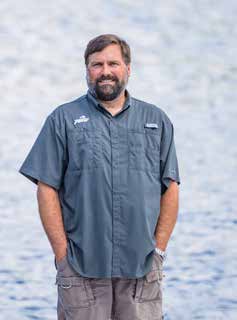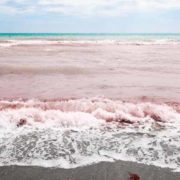ROLL TIDE?
 by Dr. Michael Parsons
by Dr. Michael Parsons
Red tide has returned to Southwest Florida.
Blooms caused by this dinoflagellate (Karenia brevis) typically show up in late September or early October. Last year, however, was not a typical year.
A red tide that was first observed in October, 2017 (coincidentally in the aftermath of Hurricane Irma) lasted for approximately 18 months; making it one of the longest lasting and most intense red tide events we have experienced in Southwest Florida in years.
One of the most frustrating aspects of last year’s bloom was the inability to reduce or remove red tide from our waters. Rather, we simply watched the red tide as it wreaked devastation on our coastal ecosystem and economy.
Why don’t we fight back against red tide? Unfortunately, such action is not a simple undertaking. Many biological controls have been proposed, including viruses, pathogenic bacteria, and even other dinoflagellates that are parasitic on red tide cells. Potential chemical controls include copper sulfate (which was even tried in 1957), hydrogen peroxide, and ozone. Physical methods, including clay flocculation and ultrasound are other possibilities.
In all cases, however, there is concern that these methods may have unintended negative impacts to the environment (e.g., killing other organisms besides red tide). We must ask ourselves, however, if such impacts will be any worse than taking no action at all; i.e., the lesser of two evils.
Additionally, by the time we realize a red tide is blooming, it is already widespread and thought to be too big to treat.
Better detection methods are needed to identify and treat a forming bloom before it gets too big.
So what are we doing in the meantime? We measure cell concentrations. We report fish kills and beach conditions.
We basically passively watch the red tide and wait for it to end its destructive cycle. At the time of writing, the College football season is halfway through. Alabama is the #1 ranked team in the country and appears unstoppable: Roll Tide.
Other college programs (especially in the SEC) are trying to find ways to defeat the Crimson Tide. Take LSU, for example. They totally revamped their offense and have (finally!) embraced the philosophy that they cannot beat Alabama by trying to prevent them from scoring points, but rather by trying to score more points.
That’s what w eneed to do with red tide in Southwest Florida. We should not passively watch the bloom and monitor its destruction. We should attack it, thereby mitigating its impacts.
Roll Tide? No – Geaux Tigers!




Leave a Reply
Want to join the discussion?Feel free to contribute!